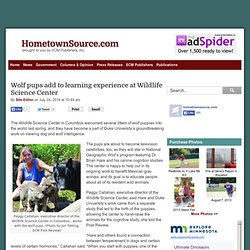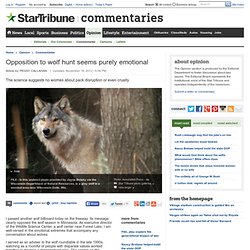

WSC donates pack of wolves to Wisconsin zoo. Wolf pups add to learning experience at Wildlife Science Center. The Wildlife Science Center in Columbus welcomed several litters of wolf puppies into the world last spring, and they have become a part of Duke University’s groundbreaking work on viewing dog and wolf intelligence.

Peggy Callahan, executive director of the Wildlife Science Center in Columbus,, works with the wolf pups. (Photo by Jon Tatting, ECM Post Review) The pups are about to become television celebrities, too, as they will star in National Geographic Wild’s program featuring Dr. Brian Hare and his canine cognition studies. The center is happy to help out in its ongoing work to benefit Mexican gray wolves, and its goal is to educate people about all of its resident wild animals. Opposition to wolf hunt seems purely emotional. I passed another wolf billboard today on the freeway.

Its message clearly opposed the wolf season in Minnesota. As executive director of the Wildlife Science Center, a wolf center near Forest Lake, I am well-versed in the emotional extremes that accompany any conversation about wolves. I served as an adviser to the wolf roundtable in the late 1990s, watching as a roomful of people with disparate values worked together to develop a management plan. The people on the roundtable had access to a panel of researchers, managers and educators who answered questions and brought science into the conversation. From what I gather, the current argument against the hunt has three concerns: 1) disruption of wolf-pack society through the death of pack members; 2) dangerous population reduction, and 3) fears of cruelty at the hands of trappers in particular.
Science appears to have left the room. In Columbus, scientists retrieve wolf sperm for future use. The effects of the sedative were wearing off Vladimir, a five-year-old Western gray wolf living at the Wildlife Science Center, so Peggy Callahan knew she had to work fast.

The center, just outside Forest Lake in Columbus, has for years worked to ensure future survival of red and gray wolves by freezing and storing their sperm. For most people, the collecting of wolf sperm is a source of disgust, but for scientists it’s genetic gold. MN Trappers Assoc display at WSC fall Harvest Howl 2012. Opposition to wolf hunt seems purely emotional. Lakeland Currents - Minnesota's Wolves - What's Next? How do you make Canadian wolves sterile? Peggy Callahan crouches low to the ground, cups her mouth with her hands and howls.

The wolf pups sitting nearby instantly raise their heads, their ears alert to the haunting call. They know that voice. Callahan has been their main caretaker since the four Canadian pups first arrived in the spring at the Wildlife Science Center in Forest Lake. They traveled all the way from British Columbia on a very special mission: to participate in a potentially groundbreaking study that researchers hope will reveal better ways to manage Canada's wolf population. The study, the result of an unusual alliance between two countries, began when a Canadian veterinarian called the Wildlife Science Center and asked whether it would be willing to take the wolf pups. Sleeping Well – Lessons from Dogs. A very strange phenomenon has happened over the past 30 years with humans – more and more humans have trouble sleeping at night.

If you watch the evening news, commercials come on all the time for sleep aids and medications for restless leg syndrome. It seems a sign of our times that spending all day in our heads in front of a computer screen at work is not a natural component to having a fulfilling job that allows our body to rest completely at night. When you think about this from an evolutionary stand point, humans used to spend most of their time feeding their families. Walking long ways to get water, harvesting the bounty for meals and hunting. All of these aspects have been changed into ordering our meals delivered to our homes and quick convenience meals in most cases. Developing a New Shock-Collar Design for Safe and Efficient Use on Wild Wolves - Hawley - 2013 - Wildlife Society Bulletin.
9/13 Learning from wolves: Peggy Callahan of the Wildlife Science Center. With beads of sweat running down her face on a steamy late-summer morning, Peggy Callahan cups hands to mouth and produces a low, long guttural wolf howl. Suddenly more than a dozen captive wolves at Callahan’s Wildlife Science Center near Forest Lake — home to some of the animals since they were pups — join the chorus, tipping their heads skyward and producing a hair-raising cacophony. Twenty seconds later they are silent. Callahan, 51, clad in a dirty tank top and shorts, with knees muddied from working in animal pens, smiles. She is clearly in her element — outdoors, knee-deep in wolves, black bears, mountain lions and other critters that are studied and displayed at her center.
This day, 20 senior citizens are visiting, and Callahan — her hands animated as she speaks — explains wolf reproduction, habits and management. “Wolves kill other wolves — for food, breeding, status,’’ she tells the group near a pen with rare Mexican gray wolves. But this is no zoo.